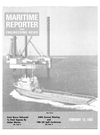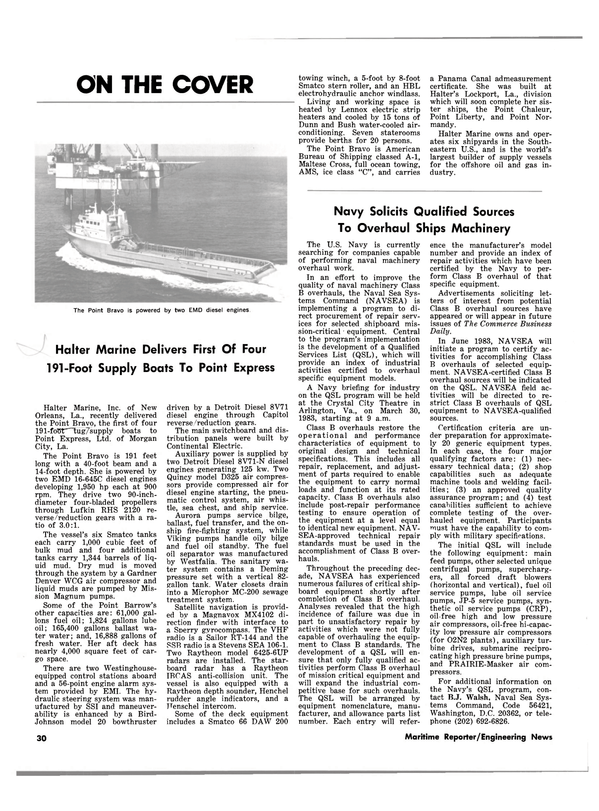
COAL EXPORTS
Substantial Growth Prospects For The U.S. Barge Industry "What we seem to lack is the determination to combine our brains and our physical resources to make our exports competitive and effective in the real world," declared H.J. Bobzien Jr., president, American Commercial Barge Line Company, in a recent speech to the Kentuckians for Better Transportation's annual Transportation Conference held in Lexington, Ky. His basic theme was based on the necessity and means to expand the export of coal.
Mr. Bobzien pointed out that the major industrial countries are switching from high-priced oil to coal and that there is a huge market for coal. However, at the same time, he said, we are not the only suppliers of coal and there is intense competition for these markets from other coal producing countries.
"There is evidence that we are losing out in these markets," he said. "The National Coal Association now predicts a decline from 104 million tons in 1982 and a further decline to 97 million tons this year." According to the speaker many factors have combined to produce this trend, but study after study singles out the U.S. transport system as a major restriction on the ability of our coal producers to compete in world markets.
Mr. Bobzien stated that "the bottom line requirements as to transport are twofold: 1. fully exploiting the enormous productivity and therefore lower cost H.J. Bobzien American Commercial potential of the water mode and, 2. controlling the excesses of rail monoply." He emphasized that water transportation is only one important part of an overall transport system of railroads, waterways, highways and pipelines, each part competing and coordinating with the other.
This means, he said, that no matter how successful a national waterway policy may be, it can be frustrated unless sound policies are developed for the transport system as a whole.
Last year Mr. Bobzien was a member of a delegation of transport officials and coal producers on a tour of European coal markets under the auspicies of the Department of Commerce. Referring to this tour, he said: "There we confirmed that we had indeed been too optimistic about the early development of the coal market, but also confirmed the strong potential for significant expansion of U.S. coal sales following general economic recovery.
Expanding European ownership of U.S. coal reserves certainly reinforces this judgment.
"I was impressed on our trip that U.S. coal has a fundamental price handicap compared to Australian and South African coal.
"This is a sobering fact," he said, "and the reason why every statement from the coal industry on its future prospects places heavy stress on the conclusion that full utilization of the nation's plentiful coal reserves can only be accomplished through reduced costs — both production and transportation costs. Transportation is a major part of the total delivered cost." Following up on this point, he pointed out that the barge industry is looking forward to a very substantial growth in its share of the total coal export market because it is the most reasonably priced means of transportation for the long haul of hundreds of millions of tons of coal. Also of significance, barge capacity can be expanded at less public and private cost than any other mode.
This means, according to the speaker, that barge efficiency acts Jr., President Barge Line Company as a substantial spur to rail efficiency through the natural workings of the market place.
Making sure that railroads possessing monopoly power are not permitted to frustrate water transport efficiencies that the coal industry needs is a major priority.
Moving from the barge industry to the ports to handle coal exports, Mr. Bobzien pointed out that "on the Gulf Coast—at Mobile and New Orleans particularly— we will see the first breakthrough in the United States in the construction of deepwater ports. The 150,000-dwt ships they will accommodate will permit savings of from $6 to $8 a ton in delivered cost. But, I must remind you that a 55-foot channel for such ships is not enough. We saw coal terminals in Rotterdam preparing to receive 300,000-dwt ships. Anyone with experience in economics can predict how quickly the coal trade will be compelled to use 300,000-dwt ships once they and the ports to handle them are available.
"Mobile and New Orleans between them have a remarkable opportunity in the next decade to become the North American counterpart of Holland's Europort.
While the rest of our country seems paralyzed on inland waterway and port development, Mobile and New Orleans could be the first to make the necessary breakthroughs for the nation." Seeing the port development in Europe made the speaker wonder how it is that the Dutch, the French, the South Africans, and the Australians can make decisions to build ports and inland waterway feeder systems to those ports, and we are paralyzed.
"The difference," it seemed to Mr. Bobzien, "is one of determination.
We have lived so long in a sort of 'fortress America' economy in which foreign trade accounted for only a tiny proportion of the whole, that we haven't yet fully adjusted our thinking to the new world in which foreign trade is increasingly a life and death matter. We do not say, we must have these markets and we must compete for them as other countries do." The financing of such projects has been a major deterent according to the speaker. Yet, he feels that it is absurd to believe that the United States cannot work out the financing when much poorer countries have found the means to build the transport projects which serve their national interests.
Mr. Bobzien suggests that "rapid progress could be made on formulating a national waterway policy responsive to the needs of the economy if the three following major principles were resolved." 1. We must have a decisionmaking process that brings on the project within a reasonable time, 2. For the purposes of financial policy making we must separate the social objectives of waterway projects from the commercial freight objectives, and 3. We must develop a consistent policy of cost recovery of the transport industry's drains on the federal treasury. The coal export market will be distorted and proper national resources allocation undermined if cost recovery applies to waterways and not to railroads.
"Taking advantage of the enormous potential for improved efficiency, productivity and dramatically lower costs readily available from the water mode, both inland and at the ports, is a necessary first step," according to Mr. Bobzien. "But the water mode and its potential provide only one part of the answer to improving export opportunities for coal. Efficient performance of the rail segment also is essential.
And here, priority must be given to moderating monoply pricing of coal transportation." On this latter point the speaker elaborated by pointing out that barge lines challenged an example of such rail monoply pricing covering discriminatory rail rates to the Ohio River that had been imposed by the N&W and C&O railroads on coal for export. On this traffic, the rail rates were anywhere from 50 cents a ton to over $5 a ton higher than rates on coal for domestic consumption. According to Mr. Bobzien these higher rates were based on the railroads' desire to see the traffic move through Atlantic tidewater ports rather than Gulf ports. He claimed that this showed the railroads' monopoly leverage when it provides the only service to the mine was thus being used to prevent or discourage a competitive rail-water alternative via the Gulf.
On the above defined case, he stated that: "The water carriers, backed by the Eastern Coal Transportation Conference and the ports of Baton Rouge and New Orleans, filed a complaint with the ICC charging that the two railroads were 'undermining competition.' We were preparing our facts to present to the ICC when N&W asked for a settlement.
The N&W offered to drop its export rates to the domestic level. Since in some important cases this would mean that the rate to the river would be comparable, cost considered, to the all-rail alternative to tidewater, we agreed to the settlement with the N&W and subsequently, on similar terms, with the C&O." In conclusion, Mr. Bobzien stated: "Whether it is permitting monopoly pricing in coal transportation by rail, or forfeiting the efficiency advantages of deepwater ports and modernized inland waterways, we are clearly allowing our export opportunities for coal to slip away.
No one believes our country is unable to perform, that our technology is lacking, or that our institutions are inadequate."
Read COAL EXPORTS in Pdf, Flash or Html5 edition of February 15, 1983 Maritime Reporter
Other stories from February 15, 1983 issue
Content
- Raytheon Service Awarded $1-Million Navy Electronics Contract For Conversions page: 4
- USCG Uses Faster, Easier Stud Welding System —Literature Available page: 8
- National Marine Opens Dock-Side Diesel Shop In Harvey, Louisiana —Literature Offered page: 8
- Burrard Yarrows Announces Two Senior Appointments page: 8
- Raytheon Company Forms New Office Of Corporate Marketing page: 8
- Successful Trials Held For Heavy Lift Vessel Sibig Venture page: 10
- Raytheon Holds SatCom Engineering Seminar page: 10
- NABRICO Names Holland Tidewater Area Distributor page: 10
- INTERNATIONAL OIL SPILL CONFERENCE page: 14
- Irvine Named General Manager And Chief Surveyor For AMT Panama page: 23
- Ocean Carriers Seeks MarAd Approval For T-5 Tankers Charter To MSC page: 24
- TeleSystems Concludes Distribution Agreement With Grove Of Canada page: 24
- Eastern Marine Delivers Trinity River To Transportation Resources page: 25
- COAL EXPORTS page: 26
- Navy Secretary Says '83 Budget Permits Fleet To Reach 600 Ships page: 27
- Halter Marine Delivers First Of Four 191-Foot Supply Boats To Point Express page: 30
- Navy Solicits Qualified Sources To Overhaul Ships Machinery page: 30
- First Of Five Tankers For USSR Christened At Rauma-Repola Yard page: 32
- LR#s Offshore Register Shows Increase Of Over 100 Units In Mobile Drilling Rigs page: 32
- $4.5 Million In Cost Increases Approved By MarAd For Two Ro/Ro's page: 32
- AWO 40 YEARS OF PROGRESS page: 34
- Navy Exercises Final Options In $1.7 Billion T-AKX Program page: 37
- Leevac Shipyards Delivers 165-Foot Supply Vessel To Offshore Express page: 38
- Bay Shipbuilding Completes Repairs To USCG Cutter Mackinaw Ahead Of Schedule page: 39
- Newport News Announces Five Executive Appointments page: 40
- USS Ticonderoga, First Of New Class Of Cruisers, Joins The Fleet page: 41
- Amos Baki Appointed Vice President At Rosenblatt & Son page: 42
- Frydenbo Names Triconn Licensee In U.S. For Rotary Steering Gear page: 42
- Report Available On Computer Data Transfer Via Maritime Satellite page: 43
- Hitachi Zosen Shipyard Delivers 53,538-Dwt Car/Bulk Carrier page: 49
- •Blount Delivers Cruise Vessel For Chesapeake Bay Service page: 49
- Air Hoists Help Speed Propeller Repair At Todd's Seattle Yard page: 49
- Asia Pacific Launches Supply Vessel For National Marine page: 54
- Malcolm Dick Elected President Of Gibbs & Cox Naval Architectural Firm page: 55
- Free Interface Offered With Texas Instruments' SatNav —Literature Available page: 55
- New Managing Director Appointed At Neorion page: 55
- General Dynamics Elects Fritz G. Tovar To New Vice Presidential Posts page: 55
- Free 24-Page Color Brochure Describes Deutz B/AM 816 Diesels page: 55
- New Model Pilot Ladder Has Easily Replaced Steps —Literature Available page: 55


